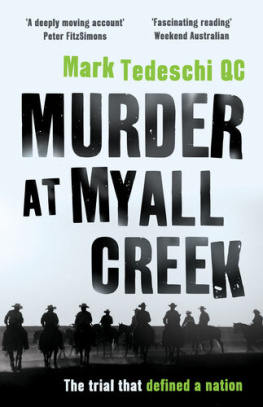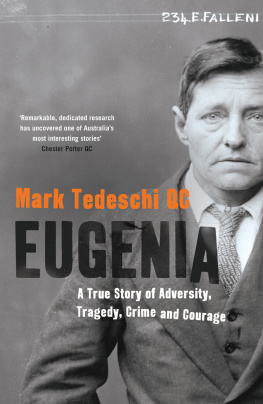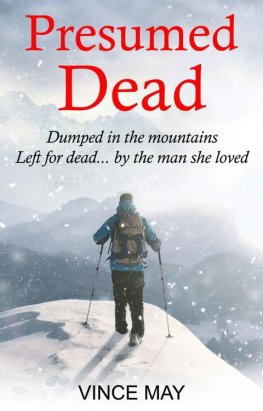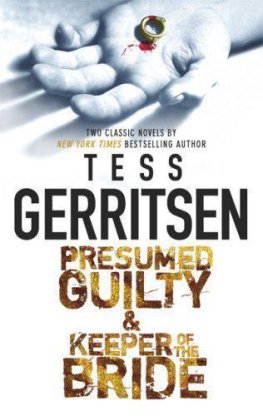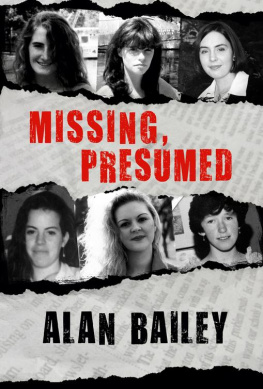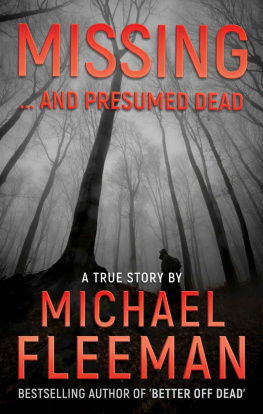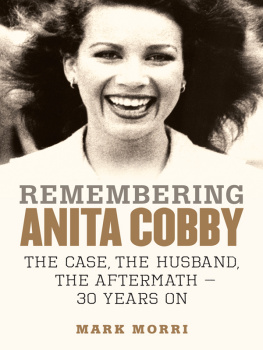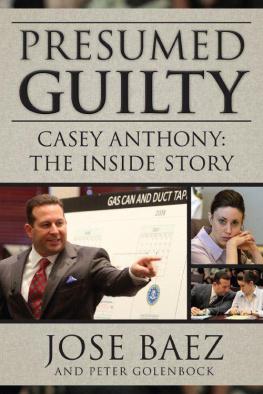Mark Tedeschi - Missing, Presumed Dead: The double murder case that shocked Australia
Here you can read online Mark Tedeschi - Missing, Presumed Dead: The double murder case that shocked Australia full text of the book (entire story) in english for free. Download pdf and epub, get meaning, cover and reviews about this ebook. year: 2022, publisher: Simon & Schuster Australia, genre: Detective and thriller. Description of the work, (preface) as well as reviews are available. Best literature library LitArk.com created for fans of good reading and offers a wide selection of genres:
Romance novel
Science fiction
Adventure
Detective
Science
History
Home and family
Prose
Art
Politics
Computer
Non-fiction
Religion
Business
Children
Humor
Choose a favorite category and find really read worthwhile books. Enjoy immersion in the world of imagination, feel the emotions of the characters or learn something new for yourself, make an fascinating discovery.
- Book:Missing, Presumed Dead: The double murder case that shocked Australia
- Author:
- Publisher:Simon & Schuster Australia
- Genre:
- Year:2022
- Rating:5 / 5
- Favourites:Add to favourites
- Your mark:
- 100
- 1
- 2
- 3
- 4
- 5
Missing, Presumed Dead: The double murder case that shocked Australia: summary, description and annotation
We offer to read an annotation, description, summary or preface (depends on what the author of the book "Missing, Presumed Dead: The double murder case that shocked Australia" wrote himself). If you haven't found the necessary information about the book — write in the comments, we will try to find it.
Mark Tedeschi: author's other books
Who wrote Missing, Presumed Dead: The double murder case that shocked Australia? Find out the surname, the name of the author of the book and a list of all author's works by series.
Missing, Presumed Dead: The double murder case that shocked Australia — read online for free the complete book (whole text) full work
Below is the text of the book, divided by pages. System saving the place of the last page read, allows you to conveniently read the book "Missing, Presumed Dead: The double murder case that shocked Australia" online for free, without having to search again every time where you left off. Put a bookmark, and you can go to the page where you finished reading at any time.
Font size:
Interval:
Bookmark:
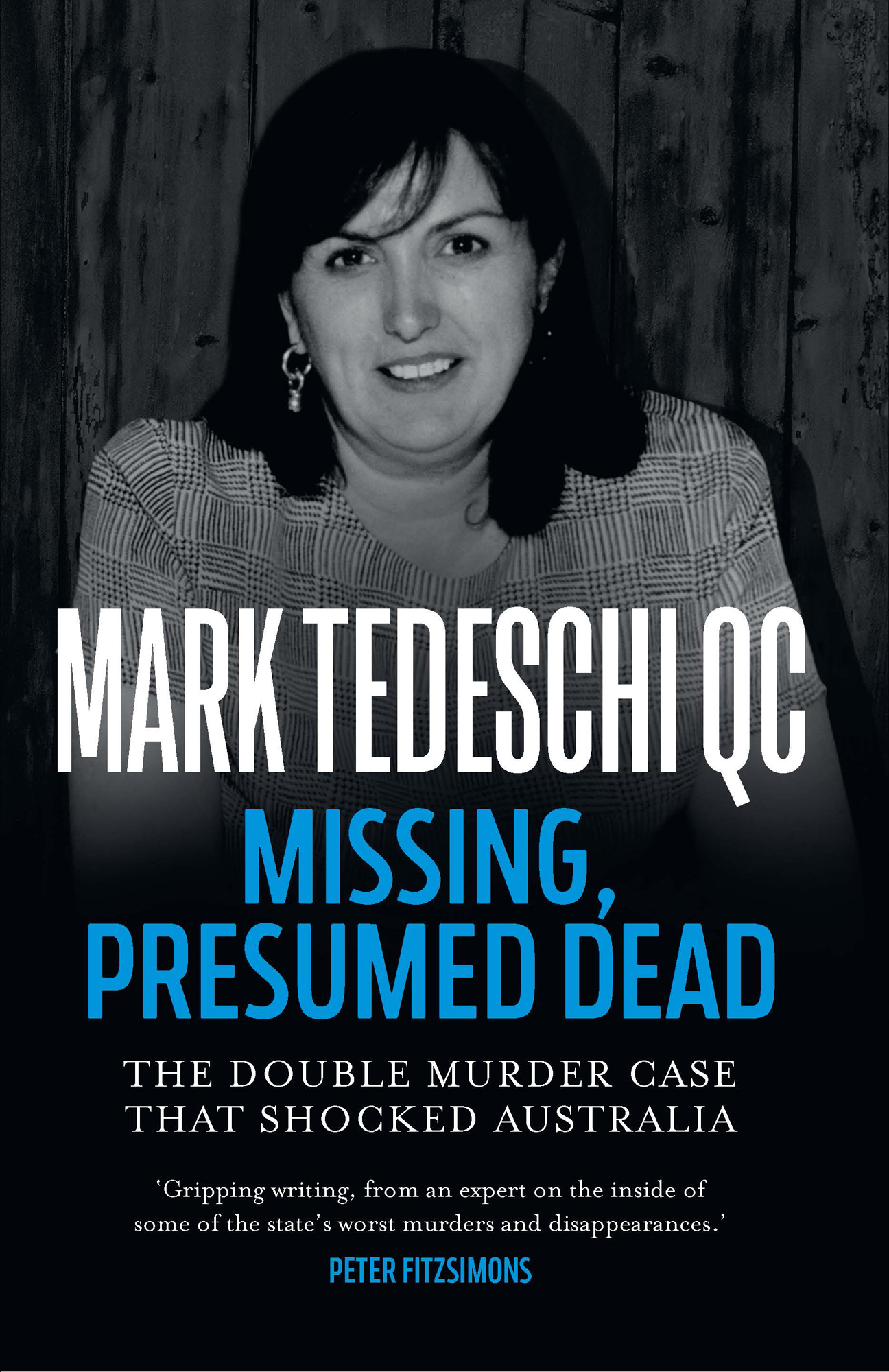
Mark Tedeschi QC
Missing, Presumed Dead
The Double Murder Case that Shocked Australia
Gripping writing, from an expert on the inside of some of the states worst murders and disappearances.
Peter Fitzsimons

The authors proceeds from the publication of this book will be donated to Australian charities that assist and support victims of crime, the families of deceased victims, and the relatives of those who have gone missing.
I dedicate this book to those Crown prosecutors who appeared with me as Junior Counsel in many of the trials that I conducted as Senior Crown Prosecutor. Their contribution to the preparation of matters and the trial process was invaluable and helped me avoid many of the pitfalls that await those who represent the community in criminal prosecutions. Many of them have gone on to have distinguished careers as Judges, Senior Counsel and leaders of the legal profession.
I wish to acknowledge the considerable assistance that I was given by former Detective Chief Inspector Dennis Bray and (now) Detective Inspector Nigel Warren. They were able to check the accuracy of many factual details that I had no way of verifying myself. I thank former Director of Public Prosecutions, Nicholas Cowdery AM QC, for reading the manuscript and making many helpful suggestions. It was the publication of his professional memoirs that gave me the courage to write this account of one of my own cases. I also wish to acknowledge the work of my literary adviser, Cindy Jones, who came up with innumerable good ideas for improving both content and style.
Extracts from the transcript of Regina v Bruce Burrell in the Supreme Court of New South Wales are reprinted with permission and are of the State of New South Wales (Department of Communities and Justice).
We have all seen their faces staring at us from notices posted in public streets or when shared on social media by worried family members. Occasionally they appear in private advertisements placed in the public notices section of suburban newspapers. Popular television programs are made about them both documentaries and dramas. They are the missing ones those who have seemingly disappeared without trace from their previous lives, leaving desperately anxious relatives who, even years later, still cling to the hope that one day their lost ones will miraculously emerge alive from the abyss of the unknown. People who have been through this experience say that it is the lack of knowledge about what has happened that is the worst aspect of their suffering. The loss of a loved one, without the definitive finding of a body, creates a living purgatory for those left behind, in which they cannot properly grieve and mostly cannot seek justice. The weight of the loss is compounded by the hope that the one who has disappeared will one day return, and is sometimes tinged with anger at the missing one as the only person they can blame for their endless suffering. Imagining what may have happened to those who have disappeared is often far worse than the knowledge of their real fate.
Those in the know mainly police or private detectives who investigate the disappearance of missing persons will tell you that there are a number of distinct categories of people who vanish forever without trace. There are the young hitchhikers who have been picked up on the roads, never to be seen again, who presumably have been sexually assaulted or robbed or both and then murdered. There are the drug dealers who have fallen foul of others in the milieu of their trade suppliers, competitors or customers. There are those who have escaped from troubled and embittered lives in order to establish new ones where they can start afresh, and who found it too confronting to say goodbye to those left behind. There are those in the throes of extreme mental anguish often due to mental illness who make the decision to put an end to their suffering, but wish to spare their loved ones the trauma of seeing their lifeless bodies. And there are those who engage in perilous solo recreational activities, like rock fishermen or wilderness adventurers, who have presumably been swallowed up by the elements while engaging in their favoured pastime. It is rare that a long-term missing person cannot be placed into one of these categories.
Apart from these, numerous people choose for a variety of reasons to make themselves scarce for a period of time, but resume their normal lives after a few days, weeks, months, or even years. There are also some who disappear, whose bodies are eventually located, and who have died in tragic or suspicious circumstances. These are not the missing ones that I am writing about in this book. This is about those who disappear, never to come back, and whose bodies are never found: they are the missing, presumed dead.
Happy, healthy, mature-age, middle-class women rarely go missing for more than a few days, and they are hardly ever among the ranks of those who are never found. Dorothy Davis and Kerry Whelan were not hitchhikers, or associates of drug dealers, or unhappy with their lives, or suffering from mental health issues. In fact, they fell well outside any of the conventional categories of people at risk of permanently disappearing.
Dorothy Davis was a 74-year-old widow who lived in the quiet, upmarket seaside suburb of Lurline Bay in south-eastern Sydney. She was financially comfortable and led a peaceful, predictable life centred around her children, grandchildren and many friends. She suffered from a few of the usual physical ailments of people of her age, including arthritis. Kerry Whelan was an active and healthy 39-year old with an affluent, family-based lifestyle. She lived with her husband, Bernie Whelan, the CEO of the Australian arm of Crown Equipment, a large multinational company that made forklifts, and their three children on an expansive rural property at Kurrajong on the north-western outskirts of Sydney, where they ran horses and enjoyed country life.
Dorothy Davis and Kerry Whelan came from different parts of Sydney, mixed in quite different circles and led completely different lives. They never met each other, and if they had, would have had little in common. In fact, Dorothy Davis and Kerry Whelan had only one thing in common they both knew Bruce Allan Burrell.
I was motivated to write this book to convey to the ordinary reader how extremely complex a police murder investigation and a subsequent criminal trial can be. Many people are surprised at the length of contemporary criminal trials, however this book may help to explain why this is so, particularly when the Crown case is a complex, circumstantial one. A circumstantial case differs from a direct evidence case, such as one in which there is eyewitness testimony or an admission of guilt by an accused person. Some people make the mistake of assuming that a circumstantial case is inherently weaker than a direct evidence case. Nothing could be further from the truth. In a circumstantial case, the Crown relies on a number of factual circumstances that in combination paint a comprehensive picture implicating the accused. No one single piece of evidence is necessarily critical. Rather, it is the accumulation of all the evidence that provides the strength of a circumstantial case.
Many people also mistakenly think that it is impossible to have a murder trial and conviction without a body. The two cases described in this book, in which there were no bodies located, demonstrate the fallacy of that view. It may be harder to prove death without a body, but there are other methods of proof, especially in the case of an adult who led a varied and vigorous life and who disappeared unexpectedly without trace.
Font size:
Interval:
Bookmark:
Similar books «Missing, Presumed Dead: The double murder case that shocked Australia»
Look at similar books to Missing, Presumed Dead: The double murder case that shocked Australia. We have selected literature similar in name and meaning in the hope of providing readers with more options to find new, interesting, not yet read works.
Discussion, reviews of the book Missing, Presumed Dead: The double murder case that shocked Australia and just readers' own opinions. Leave your comments, write what you think about the work, its meaning or the main characters. Specify what exactly you liked and what you didn't like, and why you think so.

